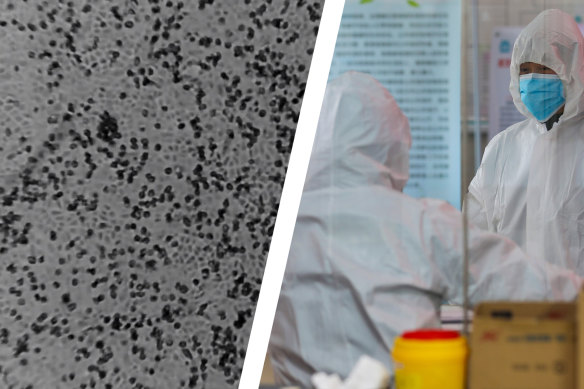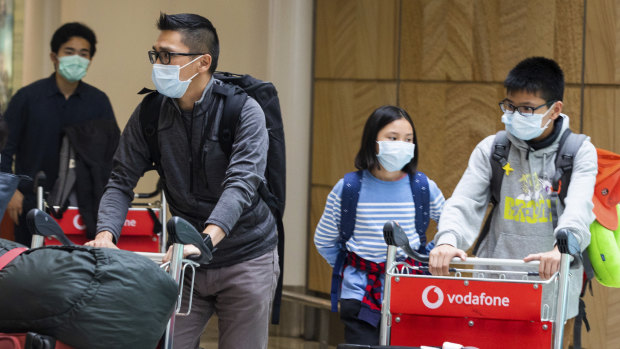This was published 5 years ago
Australian scientists first to grow Wuhan coronavirus outside China
By Jenny Noyes and Melissa Cunningham
Australian scientists have become the first outside China to grow the Wuhan coronavirus, in a breakthrough that is hoped will speed up diagnosis and aid in the development of a vaccine.
Scientists from Melbourne's Doherty Institute used a patient sample that arrived at Royal Melbourne Hospital on Friday to successfully grow the virus, announcing their "game-changing" development on Wednesday morning.

Doherty Institute screengrab of coronavirus and medical workers in Wuhan.Credit: Doherty Institute, AP
Julian Druce, head of the Doherty Institute's virus identification lab, said up to now health authorities have been using the genome sequence of the novel coronavirus to identify cases.
"Having the real virus means we now have the ability to actually validate and verify all test methods, and compare their sensitivities and specificities. It will be a game-changer for diagnosis," he said.
So far Australia has five confirmed cases of coronavirus – four in NSW and one in Victoria. All Australian cases were contracted in China, where there have now been more than 5000 confirmed cases and 106 deaths.
Outside China and Australia, more than 80 cases have been confirmed across 13 countries.
Australians have been advised via the Smartraveller website to "reconsider your need to travel to China overall", and "do not travel to Hubei province", the epicentre of the virus outbreak.
NSW students who visited China over the holidays have been asked not to attend school, TAFE or childcare services until 14 days have lapsed since they departed China. Major Australian businesses have ordered staff to do the same.

Passengers arrive at Sydney Airport on Monday wearing masks to avoid contact with the virus. Credit: Renee Nowytarger
Dr Druce said scientists had been working around the clock since receiving the sample on Friday.
"It's been 10 to 12-hour days, 2am finishes, so it's been pretty full on," he told the ABC.
The lab-grown virus will now be shared with the Australian network of public health laboratories and expert laboratories working closely with the World Health Organisation (WHO) in Europe, Dr Druce said.
It's expected to be used to generate an antibody test, which would allow detection of the virus in patients who haven’t displayed symptoms and were therefore unaware they had the virus.
It will also be used to test the effectiveness of trial vaccines.
Mike Catton, deputy director of the Doherty Institute, credited its success to Australia’s network of laboratories and public health authorities effectively working together.
Scientists at the Doherty Institute have "planned for an incident like this for many, many years and that’s really why we were able to get an answer so quickly," he said.
There are currently no proven therapies for the novel coronavirus, which authorities believe originated from a seafood market in China.
Researchers in the US, Japan and mainland China are racing to produce a vaccine for the deadly coronavirus.
US health officials announced on Wednesday an early-stage trial would begin within the next three months.
Meanwhile, Hong Kong researchers say they already developed a vaccine for coronavirus – but need time to test it.
"We have already produced the vaccine, but it will take a long time to test on animals," Infectious diseases expert Professor Yuen Kwok-yung told The South China Morning Post without giving a timeline on when it would be ready for patients.
Correction: An earlier version of the WHO infographic embedded in this story said there were four confirmed cases in the Philippines. As of January 31, there is only one case.